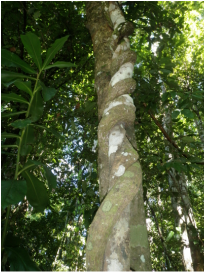
Quick tips for identifying plants:
1. Find the axillary buds to determine whether the plant is simple or complex
2. Examine the placement of the leaves and decide if the plant is opposite or alternate
3. Examine the structure of the leaves to determine if they are entire or dentate
Other useful tips:
-Determine the strength of the bark
-Look at sap color and type
-Scratch and sniff the stem or leaves
-Consult Gentry
Ten Common Plant Families:
1. Melastomataceae
- 200 genera/4,500 species
- 3-7 prominent leaf veins (commonly 3, which is a distinguishing characteristic for quick identification)
- Opposite, simple, entire
- Extremely common in the Neotropics
2. Ericaceae
- 125 genera/3,500 species
- Blueberry family
- Alternate/whorled, simple, entire
- Thrive in acidic soils
3. Moraceae
- 40 genera/1,000 species
- Milky/cafe con leche sap
- Simple, alternate (rarely opposite)
- The fig family (Ficus=genera)
4. Rubiaceae
- 611 genera/13,000 species
- Characteristic for easy identification= interpedeolar stipules
- Simple, entire, opposite (sometimes whorled)
- Coffee family
5. Piperaceae
- 10 genera/3,610 species
- Minute flowers are densely packed into rat-like spikes
- Simple, entire, and alternate, opposite, or whorled
- Pepper family
- Common genus= Piper
6. Fabaceae (or Leguminosae)
-730 genera/+14,000 species
-Third largest family of flowering plants
-Compound, entire (occasionally serate), alternate
-Typical fruit of this plant is the legume
-Cool genus= Inga
-Three subfamilies: Mimosoideae, Caesalpinioideae, Faboideae
7. Mucaseae
-2-3 genera (depending on the acceptance of Musella)/~45 species
-Simple, alternate, sheathing portions comprising a pseudotrunk
-All genera are native to the Old World
-Banana family
8. Araceae
-107 genera/3,700 species
-Characteristic for identification= spadix (type of spike inflorescence having small flowers)
-Leaves vary
-CAUTION: A number of genera contain calcium oxalate crystals in the form of raphides which are toxic.
9. Asteraceae
-1620 genera/22,750 species
-Largest family of vascular plants
-Economically important products come from composites such as cooking oils, lettuce, teas, etc.
-Simple or deeply lobed, alternate/opposite/whorled, and may be entire or dentate
-Look for resin or latex
-Sunflower family
10. Araliaceae
-55 genera/254 species
-Trees, shrubs, and lianas
-Pinnately or palmately compound or simple, alternate or opposite (rarely), entire or dentate
-Woody stem
-Ivy League
1. Find the axillary buds to determine whether the plant is simple or complex
2. Examine the placement of the leaves and decide if the plant is opposite or alternate
3. Examine the structure of the leaves to determine if they are entire or dentate
Other useful tips:
-Determine the strength of the bark
-Look at sap color and type
-Scratch and sniff the stem or leaves
-Consult Gentry
Ten Common Plant Families:
1. Melastomataceae
- 200 genera/4,500 species
- 3-7 prominent leaf veins (commonly 3, which is a distinguishing characteristic for quick identification)
- Opposite, simple, entire
- Extremely common in the Neotropics
2. Ericaceae
- 125 genera/3,500 species
- Blueberry family
- Alternate/whorled, simple, entire
- Thrive in acidic soils
3. Moraceae
- 40 genera/1,000 species
- Milky/cafe con leche sap
- Simple, alternate (rarely opposite)
- The fig family (Ficus=genera)
4. Rubiaceae
- 611 genera/13,000 species
- Characteristic for easy identification= interpedeolar stipules
- Simple, entire, opposite (sometimes whorled)
- Coffee family
5. Piperaceae
- 10 genera/3,610 species
- Minute flowers are densely packed into rat-like spikes
- Simple, entire, and alternate, opposite, or whorled
- Pepper family
- Common genus= Piper
6. Fabaceae (or Leguminosae)
-730 genera/+14,000 species
-Third largest family of flowering plants
-Compound, entire (occasionally serate), alternate
-Typical fruit of this plant is the legume
-Cool genus= Inga
-Three subfamilies: Mimosoideae, Caesalpinioideae, Faboideae
7. Mucaseae
-2-3 genera (depending on the acceptance of Musella)/~45 species
-Simple, alternate, sheathing portions comprising a pseudotrunk
-All genera are native to the Old World
-Banana family
8. Araceae
-107 genera/3,700 species
-Characteristic for identification= spadix (type of spike inflorescence having small flowers)
-Leaves vary
-CAUTION: A number of genera contain calcium oxalate crystals in the form of raphides which are toxic.
9. Asteraceae
-1620 genera/22,750 species
-Largest family of vascular plants
-Economically important products come from composites such as cooking oils, lettuce, teas, etc.
-Simple or deeply lobed, alternate/opposite/whorled, and may be entire or dentate
-Look for resin or latex
-Sunflower family
10. Araliaceae
-55 genera/254 species
-Trees, shrubs, and lianas
-Pinnately or palmately compound or simple, alternate or opposite (rarely), entire or dentate
-Woody stem
-Ivy League
